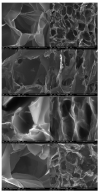Production and Mechanical Characterisation of TEMPO-Oxidised Cellulose Nanofibrils/β-Cyclodextrin Films and Cryogels
- PMID: 32443918
- PMCID: PMC7288142
- DOI: 10.3390/molecules25102381
Production and Mechanical Characterisation of TEMPO-Oxidised Cellulose Nanofibrils/β-Cyclodextrin Films and Cryogels
Abstract
Wood-based TEMPO-oxidised cellulose nanofibrils (toCNF) are promising materials for biomedical applications. Cyclodextrins have ability to form inclusion complexes with hydrophobic molecules and are considered as a method to bring new functionalities to these materials. Water sorption and mechanical properties are also key properties for biomedical applications such as drug delivery and tissue engineering. In this work, we report the modification with β-cyclodextrin (βCD) of toCNF samples with different carboxyl contents viz. 756 ± 4 µmol/g and 1048 ± 32 µmol/g. The modification was carried out at neutral and acidic pH (2.5) to study the effect of dissociation of the carboxylic acid group. Films processed by casting/evaporation at 40 °C and cryogels processed by freeze-drying were prepared from βCD modified toCNF suspensions and compared with reference samples of unmodified toCNF. The impact of modification on water sorption and mechanical properties was assessed. It was shown that the water sorption behaviour for films is driven by adsorption, with a clear impact of the chemical makeup of the fibres (charge content, pH, and adsorption of cyclodextrin). Modified toCNF cryogels (acidic pH and addition of cyclodextrins) displayed lower mechanical properties linked to the modification of the cell wall porosity structure. Esterification between βCD and toCNF under acidic conditions was performed by freeze-drying, and such cryogels exhibited a lower decrease in mechanical properties in the swollen state. These results are promising for the development of scaffold and films with controlled mechanical properties and added value due to the ability of cyclodextrin to form an inclusion complex with active principle ingredient (API) or growth factor (GF) for biomedical applications.
Keywords: cryogels; films; nanocellulose; β-cyclodextrin.
Conflict of interest statement
The authors declare no conflicts of interest.
Figures










Similar articles
-
Influence of TEMPO oxidation on the properties of ethylene glycol methyl ether acrylate grafted cellulose sponges.Carbohydr Polym. 2021 Nov 15;272:118458. doi: 10.1016/j.carbpol.2021.118458. Epub 2021 Jul 21. Carbohydr Polym. 2021. PMID: 34420718
-
Lignin nanoparticle-decorated nanocellulose cryogels as adsorbents for pharmaceutical pollutants.J Environ Manage. 2023 Mar 15;330:117210. doi: 10.1016/j.jenvman.2022.117210. Epub 2023 Jan 5. J Environ Manage. 2023. PMID: 36608603
-
Hydrophobic, ultraviolet radiation-shielding, and antioxidant functionalities of TEMPO-oxidized cellulose nanofibril film coated with modified lignin nanoparticles.Int J Biol Macromol. 2024 Oct;277(Pt 4):134464. doi: 10.1016/j.ijbiomac.2024.134464. Epub 2024 Aug 3. Int J Biol Macromol. 2024. PMID: 39098701
-
Cellulose Cryogels as Promising Materials for Biomedical Applications.Int J Mol Sci. 2022 Feb 12;23(4):2037. doi: 10.3390/ijms23042037. Int J Mol Sci. 2022. PMID: 35216150 Free PMC article. Review.
-
TEMPO-oxidized cellulose nanofibers.Nanoscale. 2011 Jan;3(1):71-85. doi: 10.1039/c0nr00583e. Epub 2010 Oct 19. Nanoscale. 2011. PMID: 20957280 Review.
Cited by
-
Preparation of TEMPO-Oxidized Cellulose Hydrogels Modified with β-Cyclodextrin and κ-Carrageenan for Potential Adsorption Applications.ACS Omega. 2024 Dec 28;10(1):972-984. doi: 10.1021/acsomega.4c08188. eCollection 2025 Jan 14. ACS Omega. 2024. PMID: 39829506 Free PMC article.
-
Cryogels: Advancing Biomaterials for Transformative Biomedical Applications.Pharmaceutics. 2023 Jun 27;15(7):1836. doi: 10.3390/pharmaceutics15071836. Pharmaceutics. 2023. PMID: 37514023 Free PMC article. Review.
-
Special Issue "Lignocellulosic Biomass".Molecules. 2021 Mar 9;26(5):1483. doi: 10.3390/molecules26051483. Molecules. 2021. PMID: 33803258 Free PMC article.
References
-
- Turbak A.F., Snyder F.W. Microfibrillated Cellulose. Patent and Trademark Office; Washington, DC, USA: 1983.
-
- Taipale T., Österberg A., Nykänen M., Ruokolainen J., Laine J. Effect of microfibrillated cellulose and fines on the drainage of kraft pulp suspension and paper strength. Cellulose. 2010;17:1005–1020. doi: 10.1007/s10570-010-9431-9. - DOI
-
- Josset S., Orsolini P., Siqueira G., Tejado A., Tingaut P., Zimmermann T. Energy consumption of the nanofibrillation of bleached pulp, wheat straw and recycled newspaper through a grinding process. Nord. Pulp Pap. Res. J. 2014;29:167–175. doi: 10.3183/npprj-2014-29-01-p167-175. - DOI
-
- Rol F., Belgacem M.N., Gandini A., Bras J. Recent advances in surface-modified cellulose nanofibrils. Prog. Polym. Sci. 2018 doi: 10.1016/j.progpolymsci.2018.09.002. - DOI
MeSH terms
Substances
Grants and funding
LinkOut - more resources
Full Text Sources

